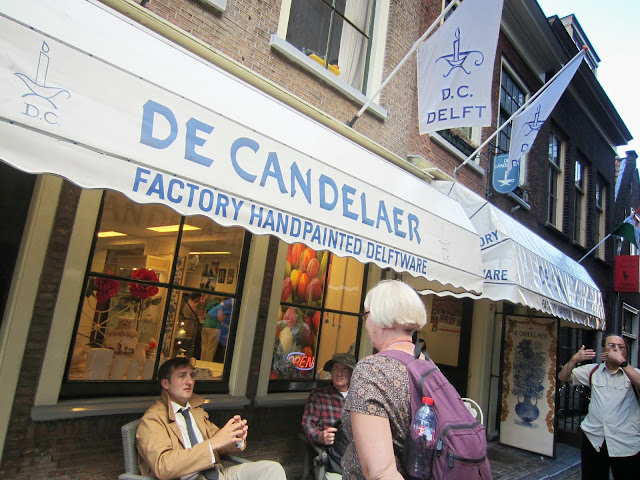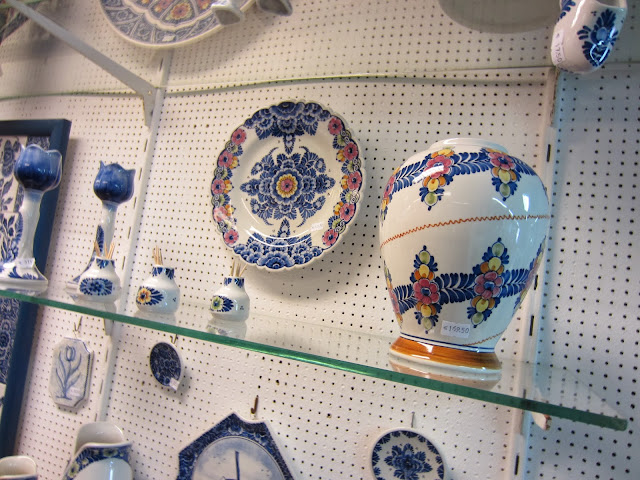Tuesday, March 4, 2014
Delftware Porcelain
Sam began collecting Delftware, I believe, during our first trip to Delft in 2000. We found our way that day to the town's biggest tourist attraction, the Koninklijke Porceleyne Fles, the original Delft Blue earthenware factory famous worldwide. It was a confusing and time-consuming walk (about 15-20 minutes, if I remember correctly) from the train station through the Markt. Sam is allergic to public transportation so we walked very quickly! We didn't know where we were at the time, never having been here, plus we were subject to the train schedules to and from Haarlem.
The Dutch East India Company, partly headquartered in Delft, imported many exotic goods from the Far East, including Chinese porcelain. Those designs became trendy and were copied by many local potters. Three centuries later, their descendants are still going strong in that factory. But there are two other (of the original 32) authentic makers still existing in Delft.
On this morning, our group tour ended at one of the last three, De Candelaer (the candlestick). This shop is owned by Stephan (wearing a New York City t-shirt), a fourth generation artisan who began making the famous porcelain at age 15. Now, the next generation is already in training as per the photo of Stephan's son hanging in the studio! Annie, his only employee, does all the painting--she told Sam and me that she has been doing it for about 40 years and began her career at the famous main factory, the one we visited in 2000. (She was already working for Stephan by that time.)
Stephan has an interesting set-up in his back room, where he demonstrates the manufacturing process by showing porcelain samples at different stages in the steps. It is a time-consuming process because each piece takes eight days to complete.
The earthenware is made from a soupy mix of clay and water, which is either rotated on a spinning disk (for plates) or poured into hollow molds (vases, cups, etc.). The porous molds work like a sponge, sucking out the water to leave a layer of dry clay along the walls of the molds. After the clay object is removed from the mold, it is fired in a kiln for 24 hours.
Pottery removed from the kiln--referred to as a "biscuit" now--is handed to Annie, the painter, who traces traditional decorations with sable-hair pencils onto the piece. These are then painted with a black paint containing cobalt oxide, which is immediately soaked up by the biscuit. Then the objects are dipped into an opaque white glaze and fired a second time. The black paint is transformed into the famous Delft Blue by a chemical reaction; and the white glaze melts into a translucent glass-like outer layer.
Stephan also explained the difference between the mass-produced versus the unauthentic pieces. You need to look for one of three symbols--each specific to the three Delft makers--to confirm a piece's authenticity. It will also say "Delft." Decals identifying pieces from China--and not authentic--say "Delft Blue." And the word "hand-painted" signals that only one small thing on the piece is actually hand-painted--not the entire surface design. Also, a crown on the decal indicates a fake.
Sam was very happy--she found a tea set which she ordered. After Stephan showed her unfinished samples, she told him what pieces she want. He finally responded--he was frankly incredulous, in my opinion: "You didn't even ask me how much these cost?" Sam flipped her hand in the air and said, "It doesn't matter."
Remember now, this was the morning of Sam's fall, her dull headache, and the continual swelling and blackening of her eyes. I guess shopping was the best way to take her mind off her medical issues, as tour buddy Kristy and I concluded! What a trooper.
Subscribe to:
Post Comments (Atom)









No comments:
Post a Comment